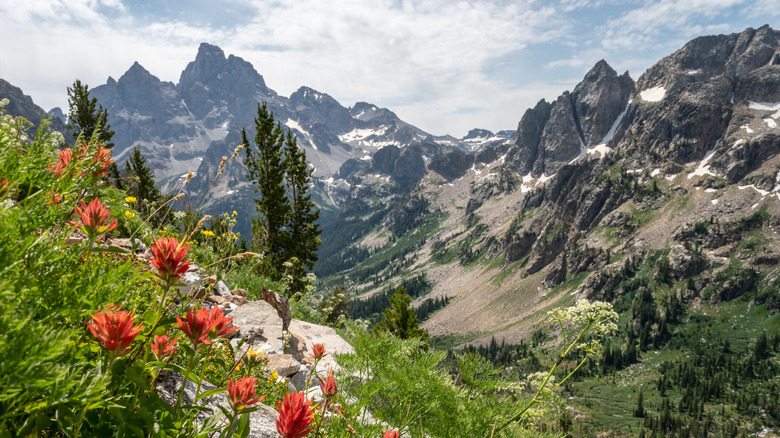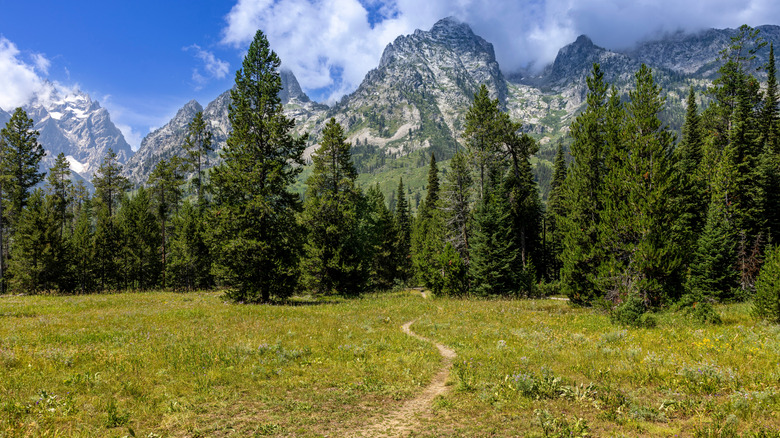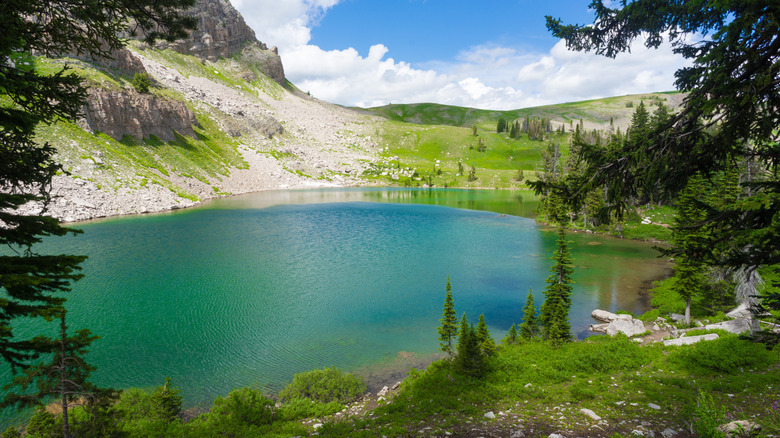Grand Teton National Park's Best Backpacking Route Is A Challenging Hike With Lakes, Wildflowers, And Views
Wyoming's Grand Teton National Park might be known as a good national park for people who don't want to hike long distances to see impressive natural landscapes, but that doesn't mean that there aren't some incredibly challenging routes through the park for those who are looking for a real adventure in the wild. The very best backpacking route through the incredible Grand Teton backcountry might just be the Teton Crest Trail. This trail takes most hikers more than twenty-one hours of hiking and climbing and takes them up a staggering 9000 feet into the mountains past chilly lakes, unbelievable wildflower fields, and spectacular views of the wild landscape of Grand Teton National Park spread out below.
While it is tremendously popular during July, August, and September, and you'll find many backpackers exploring this route and admiring the breathtaking landscapes along the way, the Teton Crest Trail (also known as the TCT) is one of those national park trails that are only for experienced hikers. This is a backcountry route, which means that you won't have access to any amenities along the trail. While a lot of people do complete this trail every year, you will probably have a lot of time to feel isolated in the wild, even if you go during peak season. A lot of the time, it will be just you and the cruel but beautiful natural environment of the Grand Tetons. This truly is a once-in-a-lifetime route that demands proper planning, extra effort on its gruelingly steep trail, and rewards with unbelievable views of one of the most popular national parks in the United States that most visitors will never get to see.
What it's like to hike the Teton Crest Trail
The beginning of this incredible route is deceptively simple: just a dirt road which takes you through some valleys. If you come at the right time of year, this hike is a mesmerizing place to see meadows of blooming wildflowers. There are places where everywhere you look will be dotted with little colorful blue, purple, and yellow flowers waving in the breeze. On your first day, you will likely reach the deep blue waters of Marion Lake, which many consider a fantastic place to camp for the night and wake up to the best views at sunrise.
From there, you'll have to take on the heart-pounding cliffs around Death Canyon Shelf. The view from here is absolutely spectacular, with green fields dotted with dark pines rising up into a sharp stony ridge. You'll likely see snow up on the peak even if the valley is alive with flowers. You're in for some more wildflower meadows as you walk the trail, which is now little more than a line of worn away plantlife in the midst of a wide, sprawling expanse of land. In the distance, you will see jagged rocks rising up into the sky like the turrets of a stone castle.
From there, however, you'll have to take on the switchbacks to Hurricane Pass, and then on to the mountainous climb up Paintbrush Divide. These steep slopes are covered in loose rocks and are certainly the most grueling part of the trail. The descent down into the canyon isn't much easier, and is often slippery with snow. From there, however, the route becomes easier, so you can spend your final hours on the trail admiring the views of the mountains and meadows.
How to plan a trip along the Teton Crest Trail
A successful hike along the Teton Crest Trail requires planning and preparation. While you may be able to simply set out on many trails, hike until you feel tired, and then either turn back or set up your tent for the night, the best way to hike the Teton Crest Trail is to plot it out in advance using the National Park Service's point to point mileage map and then add some time for heat and weather after looking at the forecast for the days of your trip. In general, the National Park Service advises moderating your pace so you never travel more than two miles in an hour, and then slowing down as you gain elevation.
You will also want to plan out where you will spend the night in advance. There are mountain camping zones, campsites by the lakes, and canyon spots along the way that you can choose from. In addition to a backcountry permit, which you will need to submit a request for through Recreation.gov, you will need to apply for permits to use the different camping zones, too. It's important to make these decisions and reserve in advance, since they do fill up. There are sites that are first come first served, too, but after an exhausting day of climbing up mountainsides you don't want to rely on luck for a good place to bed down for the night.


